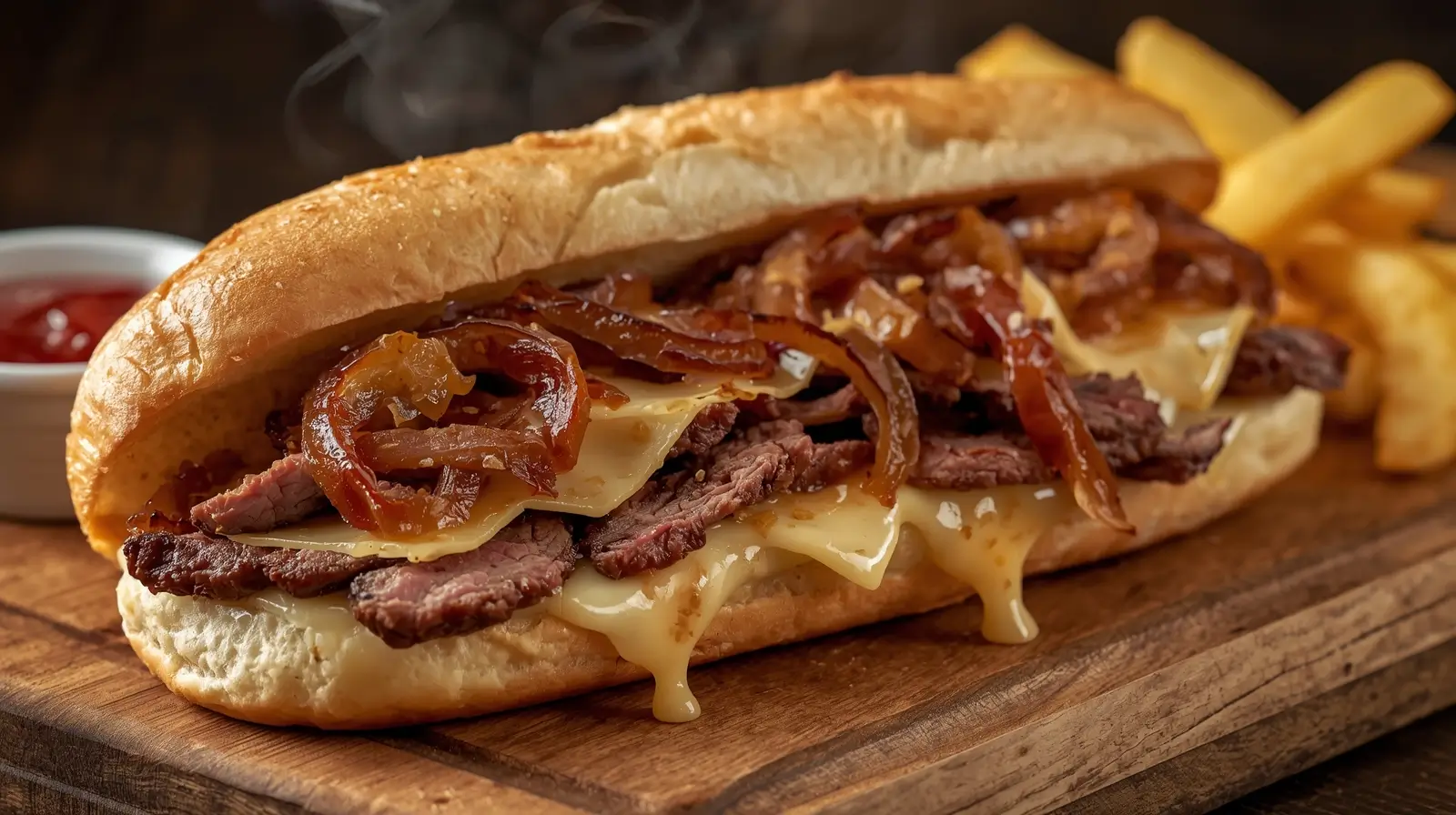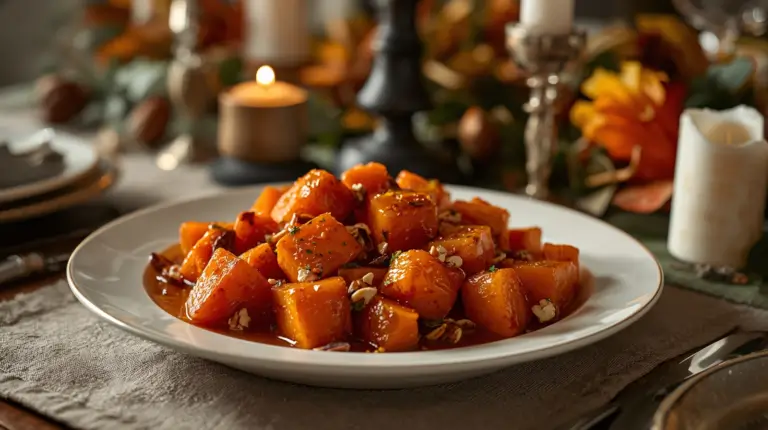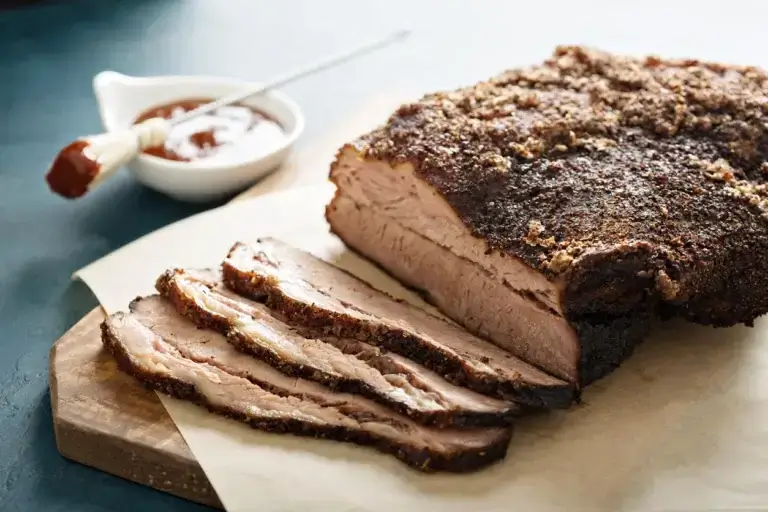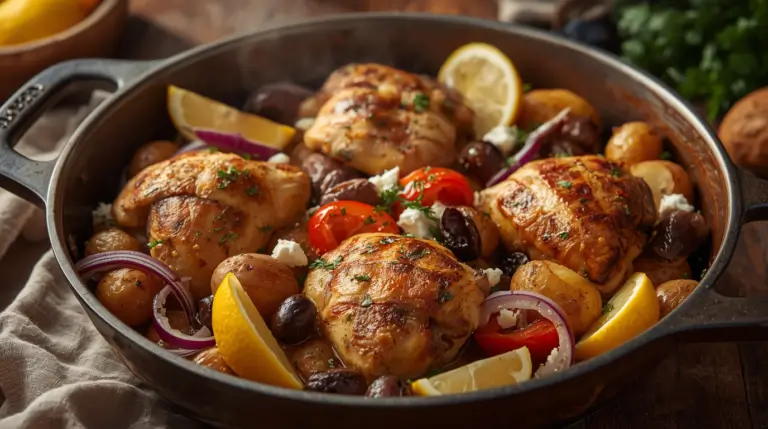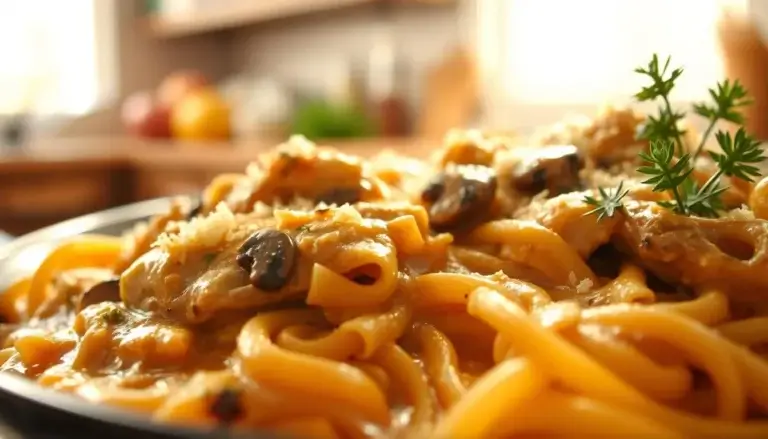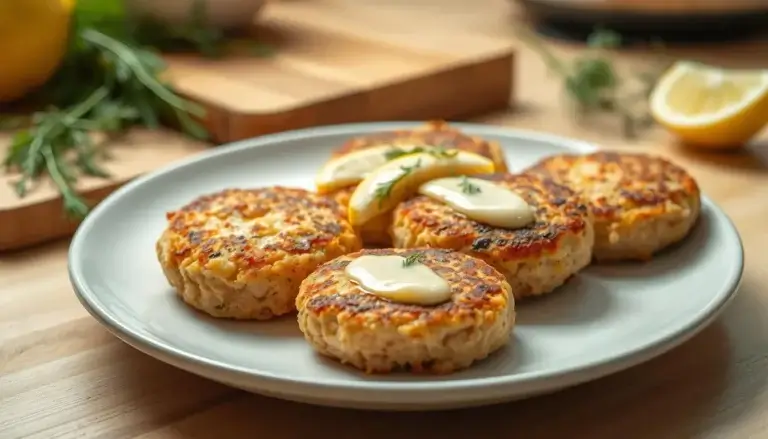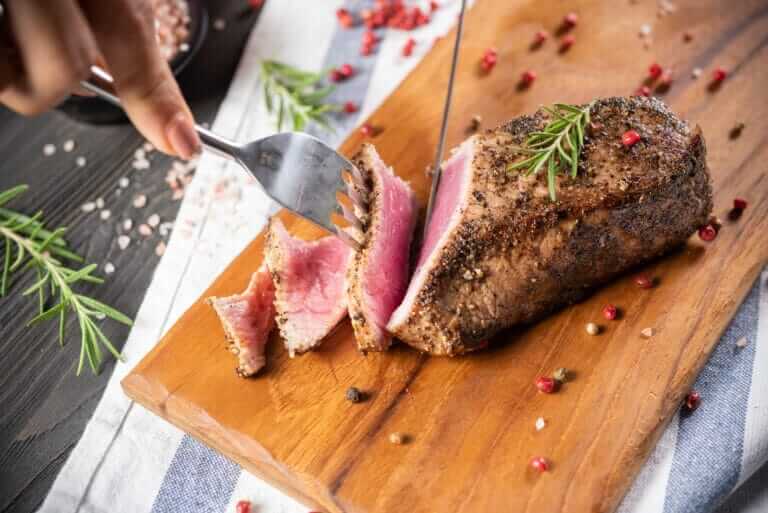Master The Best Philly Cheesesteak Recipe: Authentic and Easy
There’s something almost sacred about a proper philly cheesesteak. Not the tourist-trap versions loaded with bell peppers and mushrooms (we’ll get to that controversy later), but the real deal – thinly shaved ribeye, melted cheese, and a soft hoagie roll that’s been lightly toasted on the griddle. This philly cheesesteak recipe breaks down every technique you need to recreate Philadelphia’s most legendary sandwich in your own kitchen.
The beauty of learning to make an authentic philly cheese steak lies in its deceptive simplicity. With just a handful of quality ingredients and the right approach, you’ll achieve that perfect harmony of tender meat, gooey cheese, and pillowy bread that has made this sandwich a cultural icon since the 1930s.
Table of Contents
After the step-by-step recipe, discover the fascinating history, pro tips, and regional variations that make this sandwich truly special.
Recipe at a Glance
| Prep Time | Cook Time | Total Time | Servings |
|---|---|---|---|
| 20 mins | 12 mins | 32 mins | 4 sandwiches |
What You’ll Need
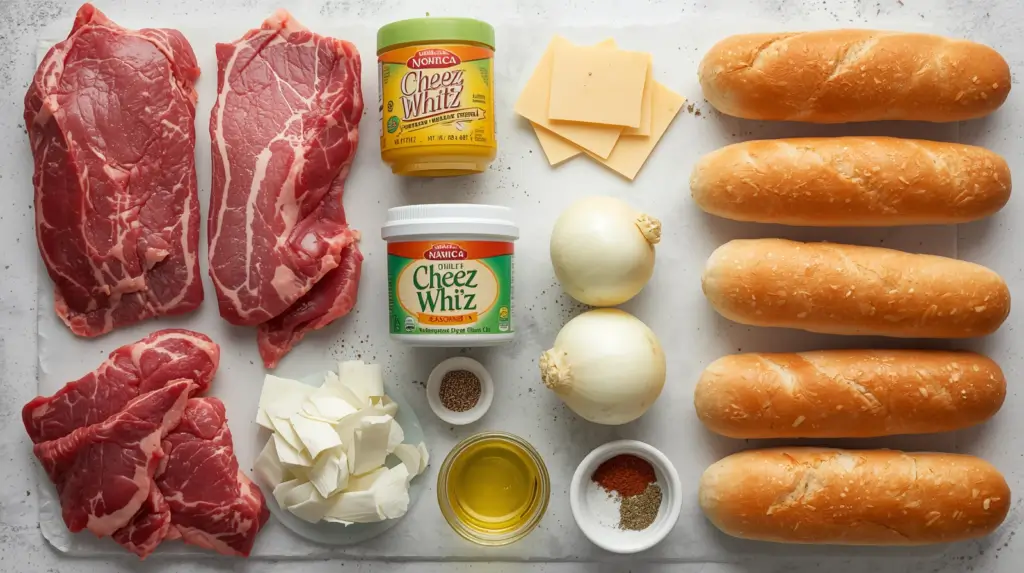
For the Steak:
- 2 lbs ribeye steak, thinly sliced (freeze for 30-45 minutes for easier slicing)
- 2 tablespoons vegetable oil
- 1 teaspoon salt
- 1/2 teaspoon black pepper
- 1/2 teaspoon garlic powder
For the Philly Cheesesteak Seasoning:
- 1 teaspoon onion powder
- 1/2 teaspoon smoked paprika
- 1/4 teaspoon cayenne pepper (optional)
- 1/4 teaspoon dried oregano
For Assembly:
- 4 authentic hoagie rolls (or Italian sub rolls)
- 8-12 slices provolone cheese (or 8 oz Cheez Whiz, or 8 oz white American cheese)
- 2 large yellow onions, thinly sliced
- 2 tablespoons butter
- Salt and pepper to taste
Customize Your Cheesesteak
- The Cheese Debate: Choose provolone for traditional flavor, Cheez Whiz for authentic Pat’s/Geno’s style, or white American for creamy perfection.
- Onion Variations: Caramelize for sweetness, leave raw for crunch, or skip entirely for “plain” style.
- Extra Toppings: Hot peppers, sweet peppers, or mushrooms (though purists will debate this).
- Spice It Up: Add banana peppers, jalapeños, or a drizzle of hot sauce.
- Lower-Fat Option: Use sirloin instead of ribeye and reduce cheese quantity.
- Hoagie Hack: Can’t find authentic rolls? Use the freshest Italian or French bread available, slightly hollowed out.
Getting Your Timing Right
Planning Ahead Matters
The secret to the best cheesesteak recipe starts with proper meat preparation. Freezing your ribeye for 30-45 minutes before slicing makes paper-thin cuts possible, which is non-negotiable for authentic texture. Meanwhile, your onions can be prepped and even caramelized ahead of time.
Temperature and Texture Goals
High heat is your friend here. Your griddle or large cast-iron skillet needs to reach 375-400°F to get that signature sear while keeping the meat tender. The philly cheese steak should melt directly on the hot meat for optimal gooeyness.
Cooking Timeline
| Step | Heat Level | Duration |
|---|---|---|
| Meat Freezing | 0°F freezer | 30-45 minutes |
| Onion Caramelization | Medium heat | 15-20 minutes |
| Griddle Preheating | High heat (375-400°F) | 5-7 minutes |
| Meat Cooking | High heat | 3-4 minutes |
| Cheese Melting | Residual heat | 1-2 minutes |
| Roll Toasting | Medium heat | 2-3 minutes |
Building Your Perfect Philly Cheesesteak
Preparing the Ribeye
Getting the Slice Right:
- Place ribeye in freezer for 30-45 minutes until firm but not frozen solid
- Using a sharp knife, slice against the grain as thin as possible (1/16 inch ideal)
- Separate slices and season with salt, pepper, and garlic powder
- Let meat come to room temperature for 15 minutes before cooking
Pro Move:
- Ask your butcher to shave the meat on their slicer if available
- Remove excess fat, but leave some marbling for flavor
- Keep slices uniform for even cooking
Cooking Process: The Griddle Method
Setting Up:
- Preheat a large cast-iron skillet or flat-top griddle on high heat
- Add 1 tablespoon vegetable oil and let it shimmer
- Have your cheese ready and within arm’s reach
- Toast rolls lightly on the griddle first, set aside
The Cooking Sequence:
- Add sliced onions to one side of the griddle with butter
- Season and cook until softened and golden (15-20 minutes for caramelized)
- Push onions aside, add remaining oil to hot surface
- Add half the seasoned beef in a thin layer, don’t move it for 1 minute
- Chop and mix the meat with two spatulas while it cooks
- After 2-3 minutes, shape into four separate piles on the griddle
- Top each pile with caramelized onions
The Cheese Application
The Critical Moment:
- Place 2-3 slices of provolone directly on each meat pile
- Cover with a metal bowl or lid to trap heat and melt cheese (30 seconds)
- For Cheez Whiz: drizzle generously over the hot meat
- For American: layer slices and let them melt into the meat
Assembly and Presentation
Bringing It Together:
- Open toasted rolls and place them face-down over each meat and cheese pile
- Use your spatula to scoop everything into the roll in one swift motion
- Press down gently to compact the filling
- Wrap bottom half in foil for authentic presentation and easy eating
Serve Immediately:
- These sandwiches wait for no one – serve hot off the griddle
- Offer hot sauce, ketchup, or pepper relish on the side
- Pair with crispy fries or chips
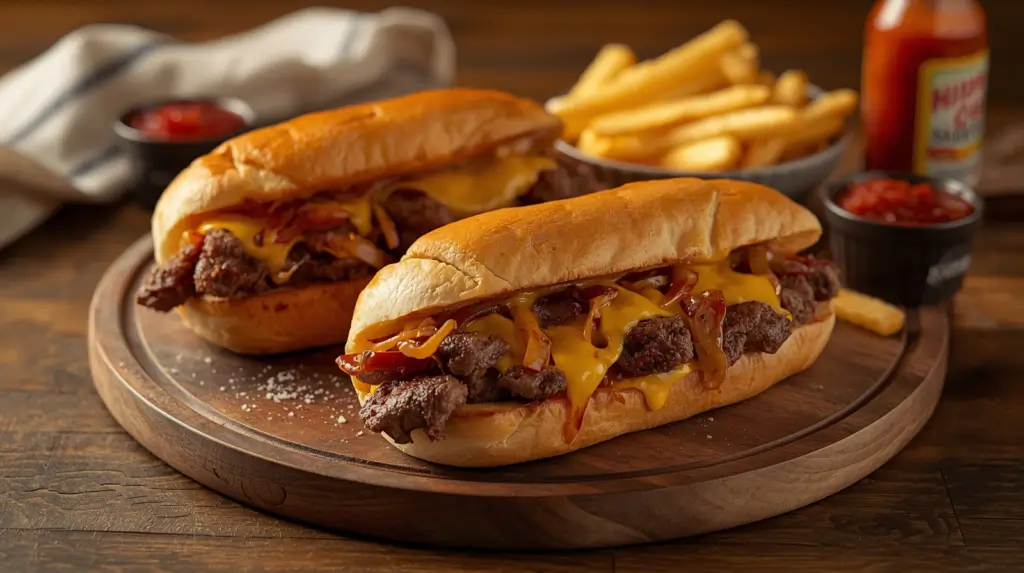
Nutritional Profile of This Philly Favorite
This philly cheesesteak recipe delivers serious protein and energy, making it a satisfying meal that keeps you full for hours. The ribeye provides essential B vitamins, iron, and zinc, while the cheese adds calcium. Yes, it’s indulgent, but sometimes that’s exactly what you need.
| Nutrient | Amount per Sandwich |
|---|---|
| Calories | 720 |
| Total Fat | 38g |
| Saturated Fat | 16g |
| Cholesterol | 145mg |
| Sodium | 1,240mg |
| Total Carbohydrates | 48g |
| Dietary Fiber | 3g |
| Sugars | 6g |
| Protein | 46g |
| Iron | 28% DV |
| Calcium | 35% DV |
Want to know the secrets that separate good from legendary? Keep reading!
Why This Philly Cheese Steak Recipe Works Every Time
- Authentic technique straight from South Philly griddle masters
- Simple ingredients mean the quality of each component truly shines through
- Foolproof instructions remove the guesswork and guarantee crispy edges with tender centers
- Flexible cheese options let you choose your camp in the great cheese debate
- Restaurant-quality results without needing commercial equipment
- Quick cooking time makes this perfect for weeknight dinners or game day crowds
From Street Food to National Treasure
What started in 1930 as Pat Olivieri’s hot dog cart experiment became Philadelphia’s culinary calling card. The story goes that Pat, a hot dog vendor in South Philadelphia, got tired of eating his own product and decided to grill some beef from the butcher with onions instead. A cab driver smelled it, wanted one, and suggested Pat quit the hot dog business. The rest is delicious history.
I remember my first real philly cheese steak in Philadelphia about fifteen years ago. I’d ordered it “wit” (with onions) because I’d read that’s what locals do, and when the guy behind the counter slapped that wrapped masterpiece on the counter, I understood immediately why people are so passionate about this sandwich. The meat was so tender it practically melted, the cheese was drippy in the best way, and that roll – slightly crispy outside, impossibly soft inside – held everything together like it was engineered specifically for that purpose.
The Chemistry of a Great Cheesesteak
What Makes the Meat Perfect
The ribeye cut isn’t arbitrary – it’s chosen for its marbling and fat content, which creates incredible tenderness when cooked quickly at high heat. Slicing the meat paper-thin increases surface area, allowing for maximum flavor development and that signature texture where the beef almost dissolves in your mouth.
The high-heat sear creates the Maillard reaction, developing complex, savory flavors while keeping the interior tender. The philly cheesesteak seasoning blend enhances but never overpowers the natural beef flavor.
Why Cheese Selection Matters
The great cheese debate isn’t just about taste – it’s about melting properties. Provolone offers sharp, tangy notes and melts beautifully. Cheez Whiz provides instant, uniform coverage and that nostalgic flavor. White American melts seamlessly and adds creamy richness without overwhelming the beef. Each creates a different textural experience.
What Makes This the Best Cheesesteak Recipe
People searching for philly cheesesteak recipes want authenticity without traveling to Philadelphia. This version delivers exactly that by respecting traditional techniques while adapting to home kitchens. The key differences between mediocre and exceptional results come down to three things: paper-thin meat, proper heat management, and quality ingredients.
| Feature | Average Homemade | This Best Cheesesteak Recipe |
|---|---|---|
| Meat Thickness | Chunky pieces | Paper-thin shaved |
| Cooking Surface | Medium heat pan | High-heat griddle |
| Cheese Method | Melted separately | Melted directly on meat |
| Roll Treatment | Cold or microwaved | Toasted on griddle |
| Cooking Time | 10+ minutes | 3-4 minutes |
| Texture Result | Chewy, dry | Tender, juicy |
Selecting the Right Ingredients
The Beef Breakdown
Ribeye is traditional for good reason – the fat marbling keeps meat tender during high-heat cooking. Look for ribeye with good marbling throughout. If ribeye stretches your budget, top round can work but requires extra attention to avoid toughness. Never use pre-sliced “sandwich steak” – the cuts are too thick.
Choosing Your Philly Cheese Steak Cheese
The holy trinity of cheesesteak cheese each has devoted followers:
- Provolone: Sharp, traditional, melts well with some texture remaining
- Cheez Whiz: Controversial but authentic to Pat’s and Geno’s, ultra-smooth
- White American: Creamy middle ground, melts perfectly, mild flavor
The Roll Makes or Breaks It
Amoroso rolls are the gold standard in Philly, but outside the region, look for Italian hoagie rolls with these characteristics: soft interior, slightly crispy crust, ability to hold moisture without getting soggy, and about 10-12 inches long. The roll should be fresh – day-old bread turns this sandwich into a jaw workout.
Make-Ahead Strategies
Prepare components separately for faster execution. Slice and season the ribeye up to 6 hours ahead, storing covered in the refrigerator. Caramelize onions up to 3 days in advance and reheat when needed. Pre-portion cheese slices so you can grab and go. The actual cooking must happen right before serving – there’s no way around that if you want the authentic experience.
Professional Techniques for Home Cooks
Common Pitfalls and How to Avoid Them
- The Thick Slice Trap: Thick meat becomes chewy and tough. Always slice paper-thin or have your butcher do it.
- Temperature Troubles: Cooking at too low heat creates gray, steamed meat instead of caramelized beef. Crank that heat up.
- The Overload Problem: Too much meat per sandwich makes it impossible to eat and the bread gets soggy. Less is more.
- Cheese Timing Fails: Adding cheese too early means it overcooks and becomes rubbery. Wait until the last minute.
Advanced Tricks from the Pros
Double-Griddle Method: If you’re making multiple sandwiches, keep one griddle for meat and one for onions and cheese to work more efficiently.
The Chop Technique: Use two metal spatulas to continuously chop and flip the meat while cooking. This creates the perfect texture and prevents clumping.
Roll Steaming: Place rolls over the cooking meat briefly to steam them with the meat’s moisture – this is what they do at the famous stands.
Creative Takes on the Classic
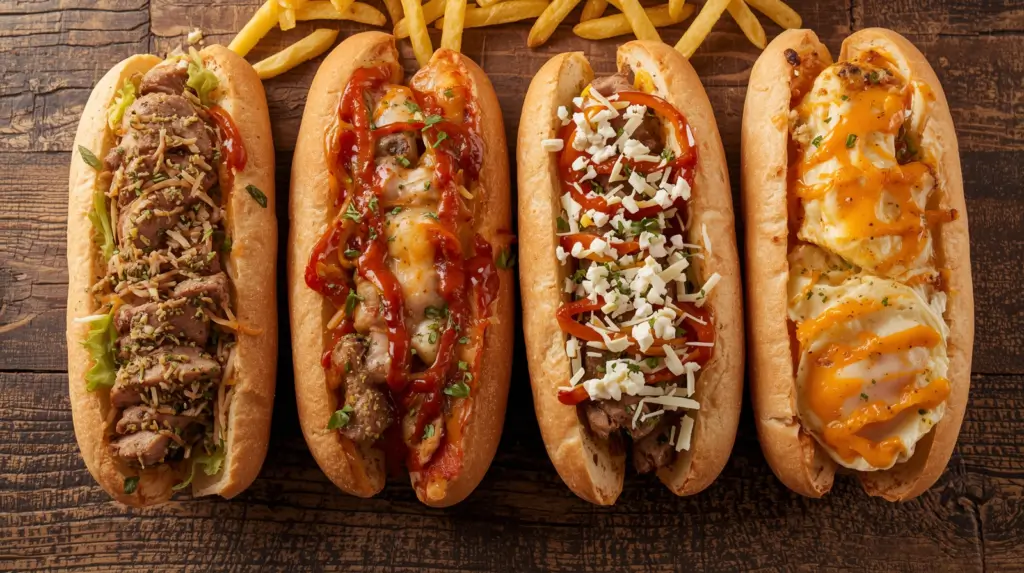
Regional Riffs Worth Trying
Chicken Cheesesteak Spin: Substitute thinly sliced chicken breast for beef, season with Italian herbs, perfect for those who don’t eat red meat.
Pizza Steak Fusion: Add marinara sauce and mozzarella for a Philadelphia-Italian mashup that’s surprisingly popular in the city.
Buffalo Cheesesteak Twist: Toss the cooked beef with buffalo sauce before adding blue cheese crumbles instead of traditional cheese options.
Breakfast Steak Adventure: Add scrambled eggs and swap provolone for cheddar, creating the ultimate breakfast sandwich using cheesesteak techniques.
Plating and Perfect Partners
Making It Look as Good as It Tastes
Wrap the bottom third of each sandwich in aluminum foil or parchment paper – this is authentic to Philadelphia stands and serves the practical purpose of catching drips while keeping your hands clean. Cut on a diagonal to show off the meat and cheese interior. Serve on deli paper or in red plastic baskets for that street food vibe.
What to Serve Alongside
Classic Combinations:
- Crispy boardwalk fries with malt vinegar
- Old Bay seasoned potato wedges
- Creamy coleslaw with celery seed
- Dill pickle spears
Elevated Sides:
- Truffle parmesan fries with herb aioli
- Beer-battered onion rings
- Roasted Brussels sprouts with turkey bacon
- Garden salad with Italian vinaigrette
Drink Pairings:
- Classic Coca-Cola or root beer
- Fresh lemonade with a hint of mint
- Iced tea with peach or raspberry
- Sparkling water with lime and fresh herbs
Storing and Reviving Leftovers
Let’s be honest – cheesesteaks are best eaten immediately, but life happens. Store leftover components separately if possible: wrap meat and onions together, keep bread separate. Refrigerate for up to 2 days maximum.
Reheating Wisdom: Separate the meat from the roll. Reheat meat with a splash of beef broth in a covered skillet over medium heat for 3-4 minutes. Toast the roll separately. Reassemble with fresh cheese. This won’t match the original, but it’s respectable.
Better Leftover Uses: Chop the meat and cheese mixture for cheesesteak quesadillas, stir into scrambled eggs for breakfast, mix with rice for a quick bowl, or dice for a loaded baked potato topping.
Your Burning Questions Answered
How thin should I slice the ribeye for this philly cheesesteak recipe? Aim for 1/16 inch thickness – almost translucent. Freezing the meat for 30-45 minutes makes this much easier. If you can’t achieve this at home, ask your butcher to run it through their slicer.
What’s the authentic philly cheesesteak? This sparks heated debates, but all three are legitimate: Cheez Whiz (Pat’s and Geno’s standard), provolone (slightly more upscale spots), and white American (many local favorites). Choose based on your preference – there’s no single “right” answer.
Should I use onions in an authentic philly cheese steak? Tradition says yes, but ordering it “without” is completely acceptable in Philadelphia. Caramelized onions add sweetness and moisture, but a plain cheesesteak lets the beef shine.
Can I make this philly cheesesteak recipe without a griddle? Absolutely. Use your largest cast-iron skillet or heavy-bottomed pan over high heat. You might need to work in batches, but the results will still be excellent.
What’s the deal with peppers and mushrooms? In Philadelphia, these are considered add-ons, not standard. A “cheesesteak” traditionally means meat, cheese, and optionally onions. Everything else is customization. Don’t let anyone shame you for your preferences, though.
How do I prevent my roll from getting soggy? Toast it lightly on the griddle first, don’t overfill the sandwich, and serve immediately. The foil wrap helps contain moisture without it soaking into the bottom of the bread.
Can I prep the philly cheesesteak seasoning in advance? Yes! Mix all dry seasonings and store in an airtight container for up to 3 months. This makes weeknight cooking even faster.
Ready to bring the taste of South Philadelphia into your kitchen? Grab that ribeye and let’s get cooking – your best homemade philly cheese steak is just 32 minutes away!
Leave a Review
There are no reviews yet. Be the first one to write one.

